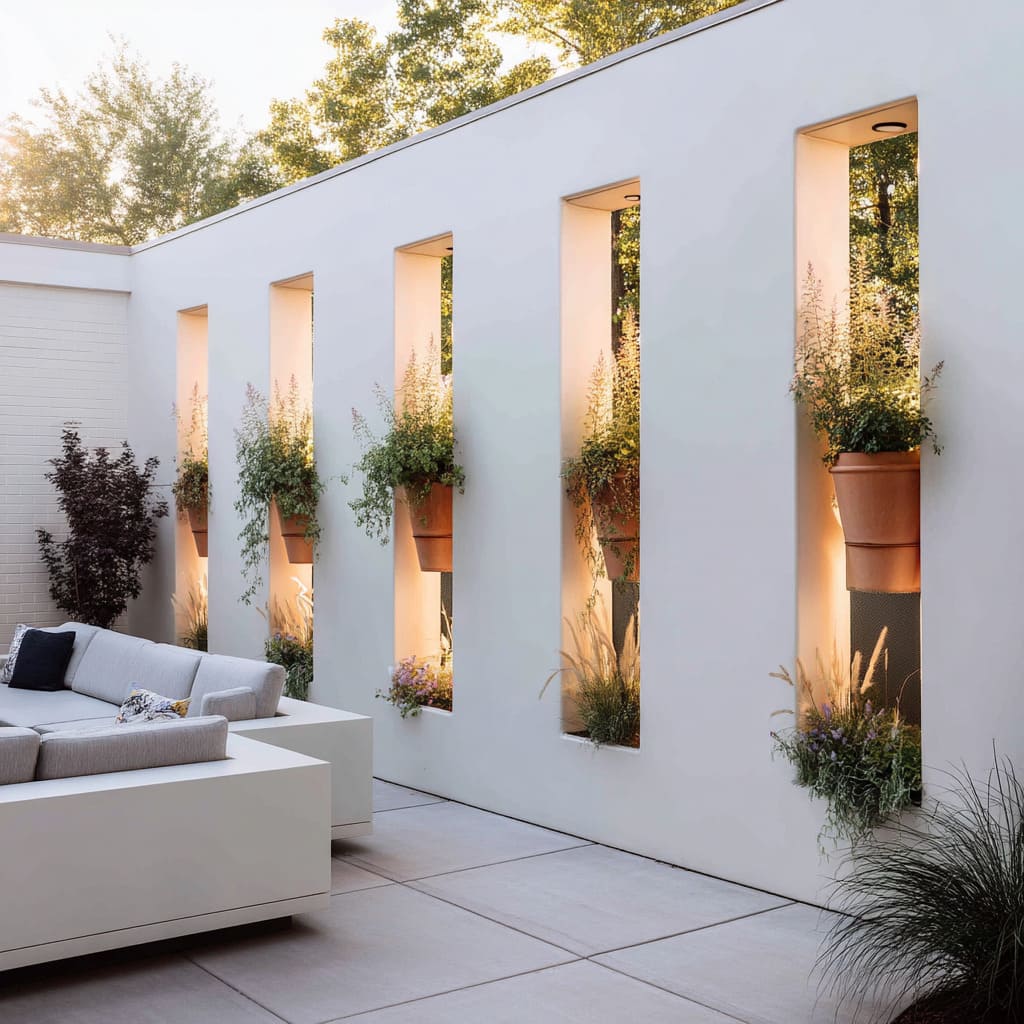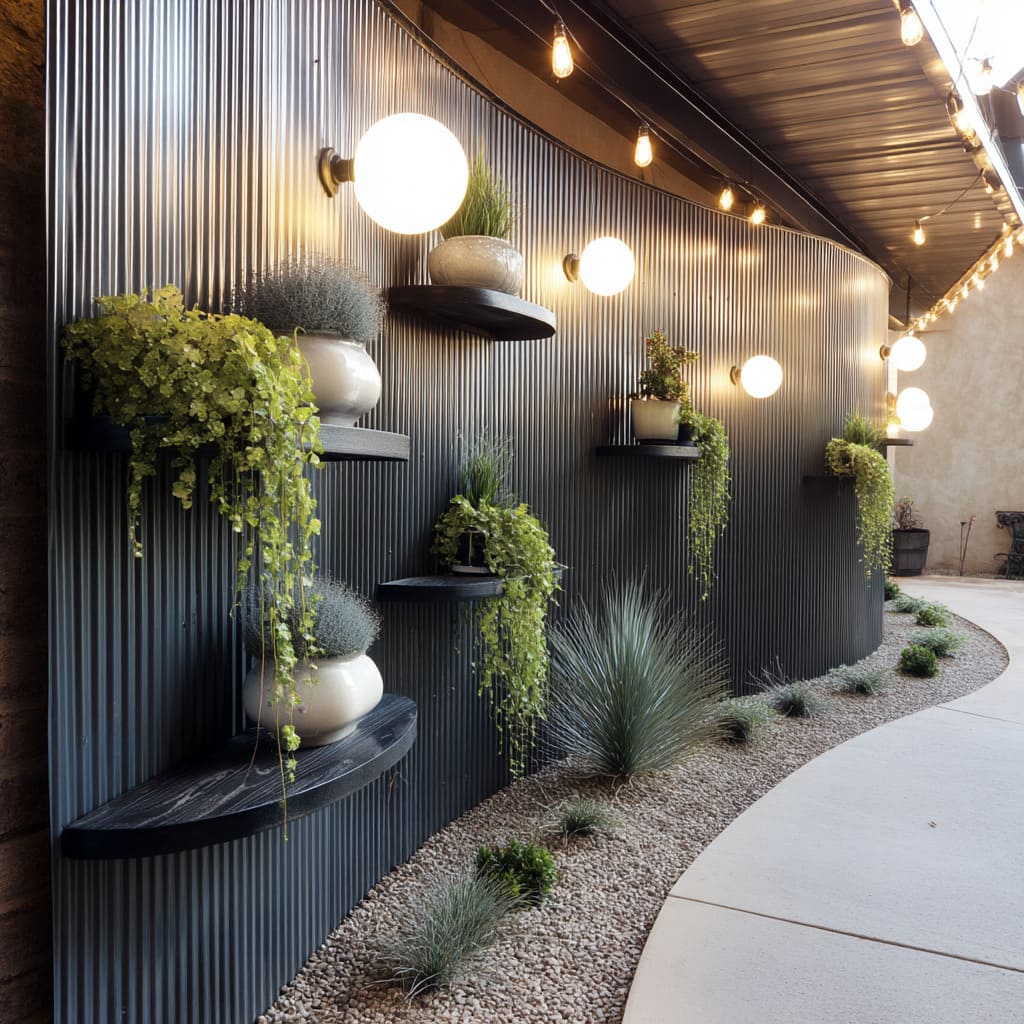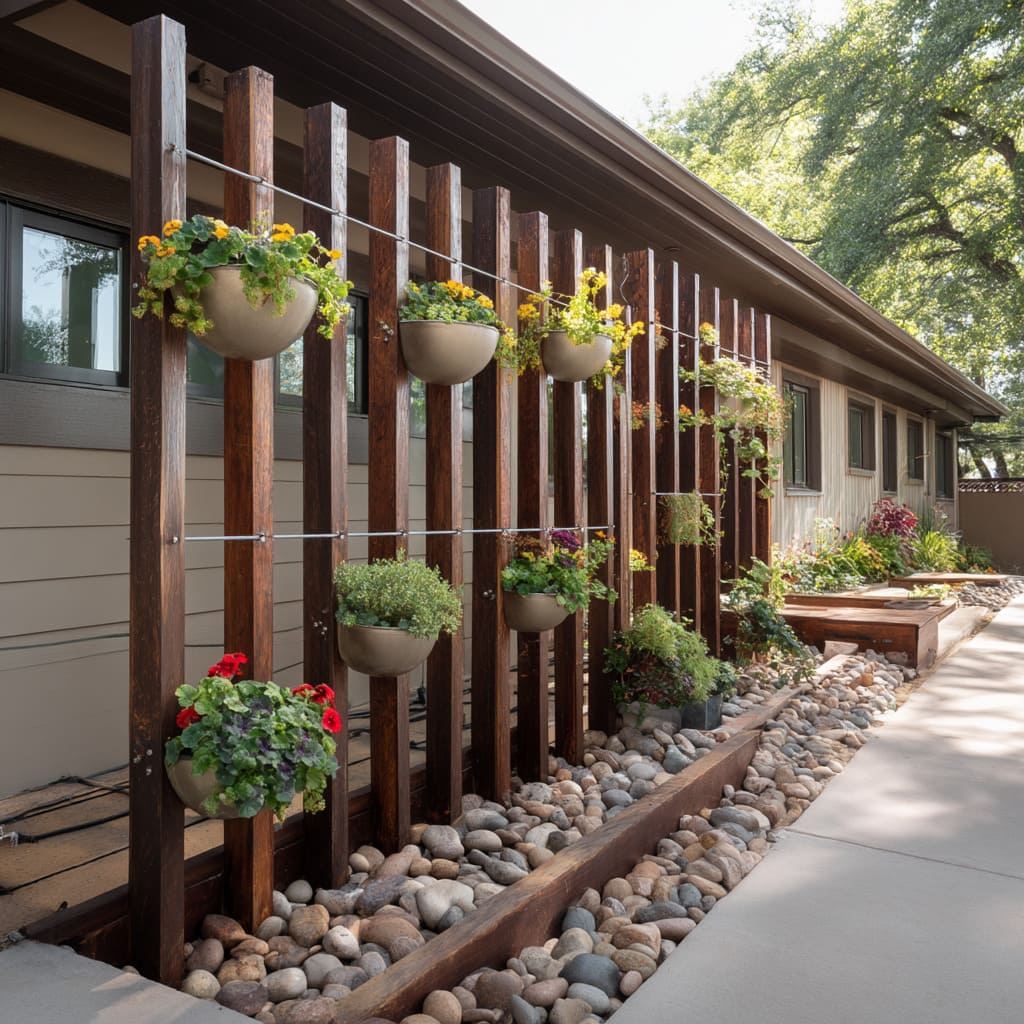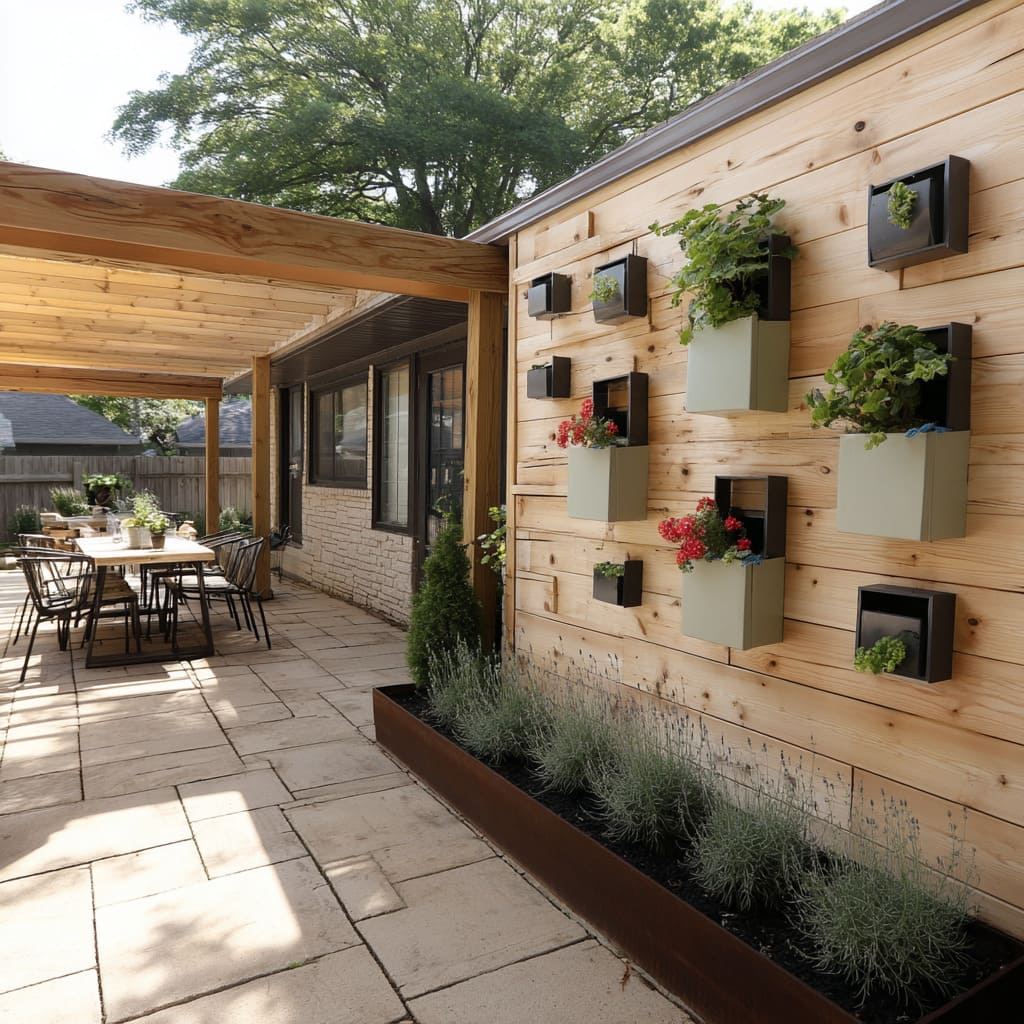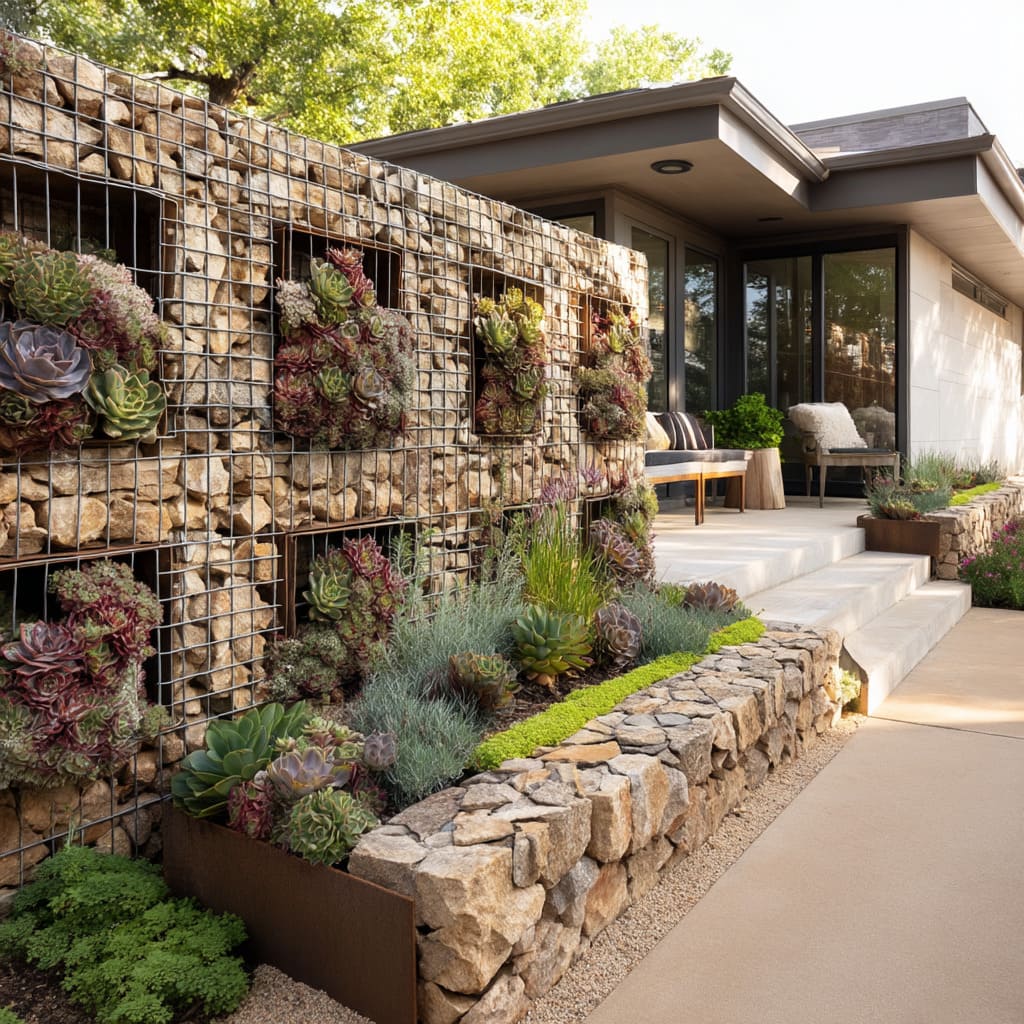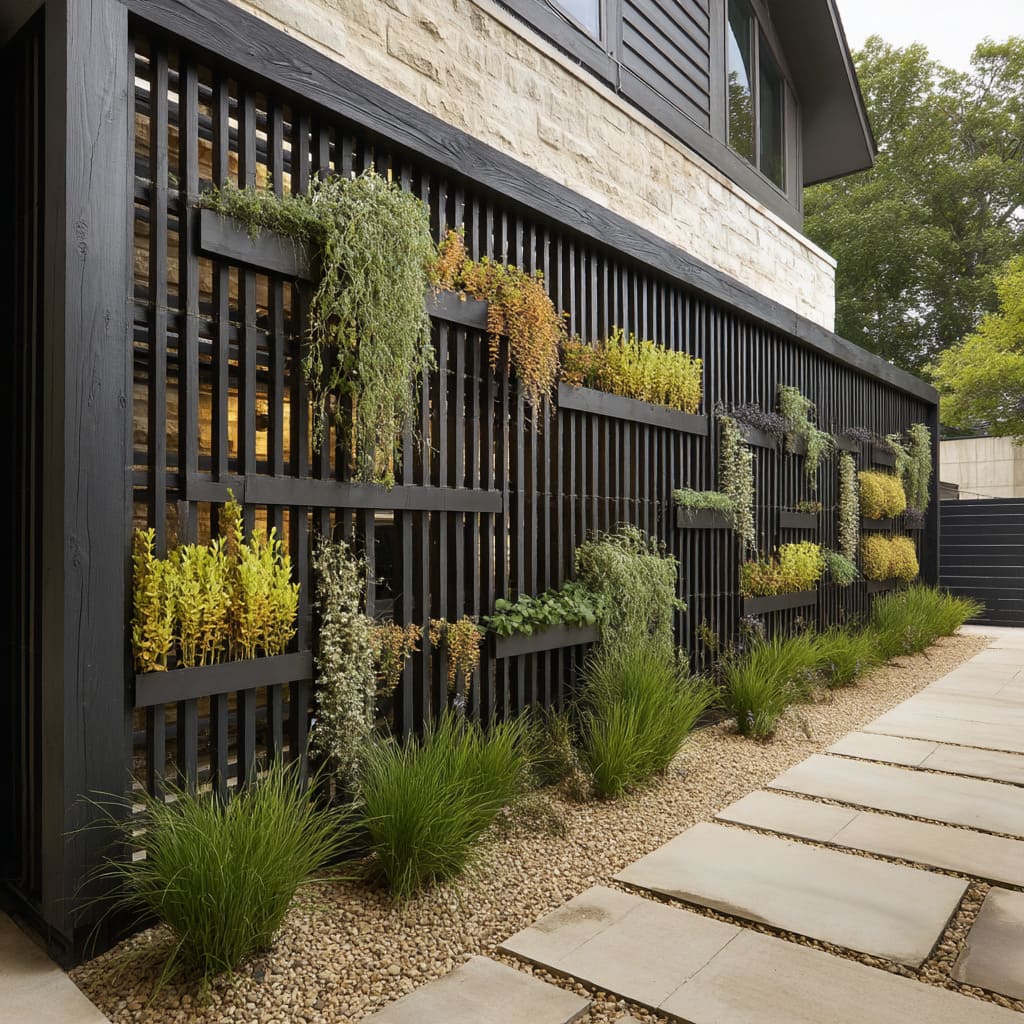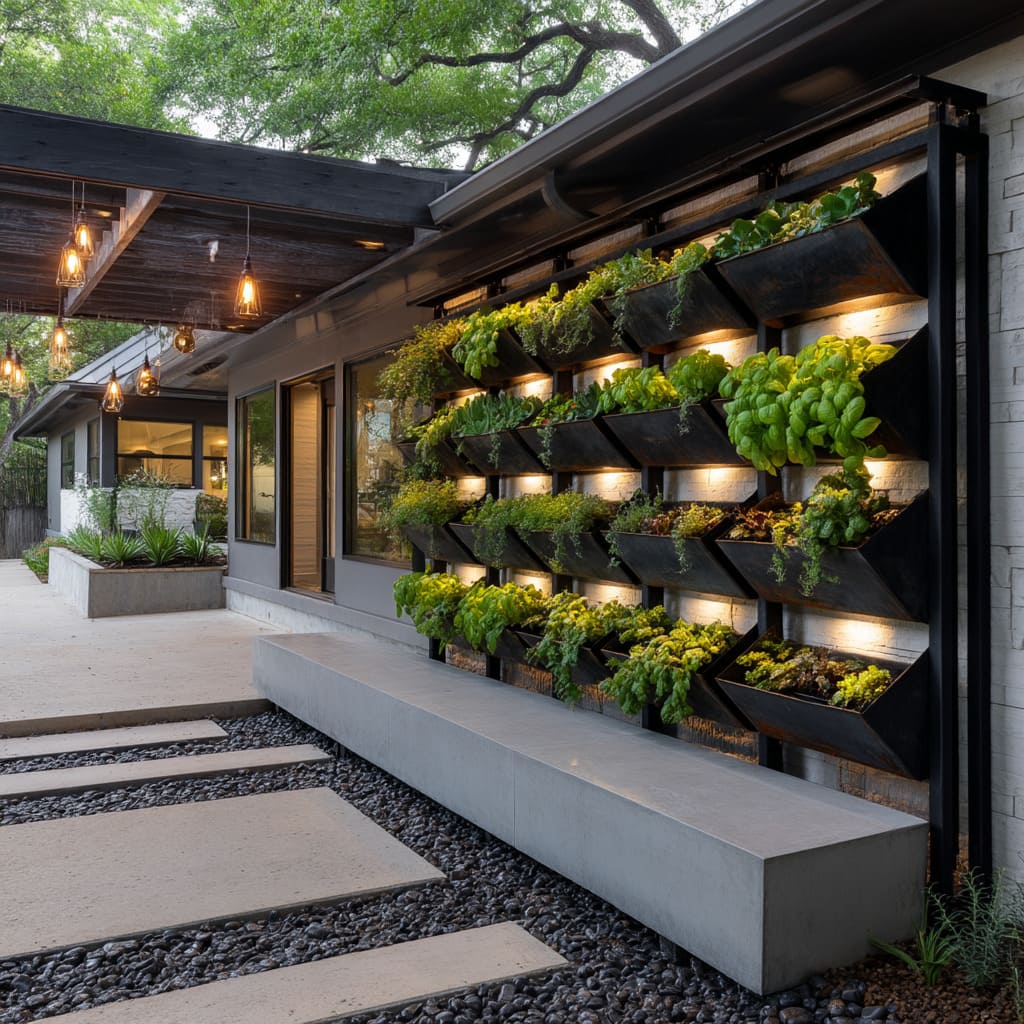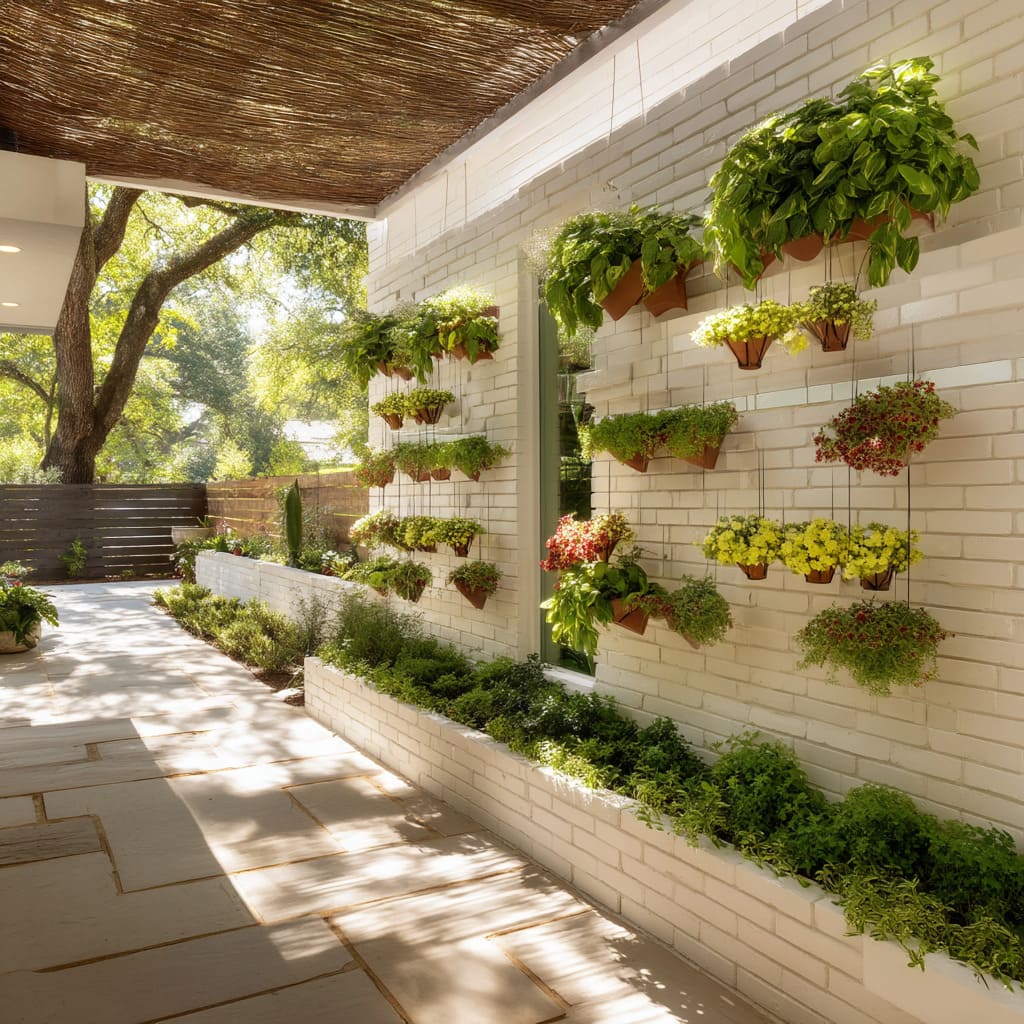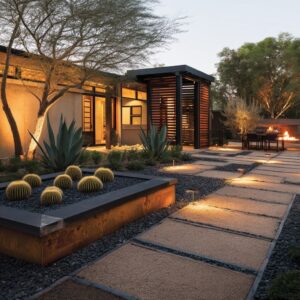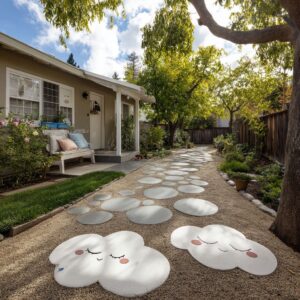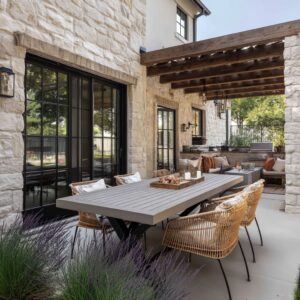Outdoor walls are no longer just backdrops—they’ve become active surfaces that shape the atmosphere of a yard. Across patios, courtyards, and small side gardens, these walls are taking on layered roles.
Some act as support structures for foliage, others mix storage with lighting, and many blur the line between vertical garden and architectural feature. What connects them isn’t a single look, but a shared approach: using structure, planting, light, and materials to create visual rhythm and spatial depth.
Sometimes, details are doing the heavy lifting. From fluted shadows that shift throughout the day to soft-edged planters chosen more for their texture than their bloom, the focus has moved toward composition and pacing.
The most effective walls don’t try to fill every inch. Instead, they know when to leave space open and when to let light or foliage take the lead.
Plants Used as Textural Mass, Not Just Decoration
In many outdoor wall designs today, plants aren’t picked only for their shape or shade of green—they’re selected for how they sit inside the structure and how their textures interact with lines, shadows, and architectural edges. Foliage becomes part of the spatial balance, sometimes acting as a soft layer over sharp geometry or even changing how heavy a wall appears.
Trailing varieties like asparagus fern, creeping Jenny, and baby’s tears are used again and again for their softness. Their fine tendrils and gentle arcs fill tight spaces and help ease the hardness of grid systems.
They hang, spill, and shift with breeze and time, making even rigid structures feel more alive and flexible. Other plants—coleus with its full leaves, mint with its fresh green body, sedum with its firm, low-mounding shape—are chosen to sit in more static positions.
These aren’t just decorative dots; they’re anchors that pull visual weight down into the layout. In walls where symmetry is intentionally broken, these plants help hold the eye steady and build a visual base.
This approach is rooted in shaping mass. Foliage becomes a way to manage light fall, tone shifts, and surface depth.
Greenery isn’t just filling space—it’s helping to write the visual rhythm of a wall that’s designed to be read slowly, with attention to texture and balance.
Modular Planting Systems as Compositional Canvas
In many recent outdoor living wall ideas, the focus has shifted toward modularity not as a rigid structure but as a canvas that supports soft visual movement. These walls treat each planter pocket, shelf, or cubby as part of a larger rhythm, similar to how brushstrokes form a painting.
The effect is structured but not stiff—each unit plays a role, but some are left open intentionally. Take the vertical framed wood slat boxes, for example.
Their loose alternating pattern of leafy greens and negative space avoids predictability. Some boxes are filled with trailing string-of-pearls or upright coleus, while others hold sculptural objects or remain completely open, letting shadow fill the gap.
The rhythm feels light, giving the plants space to breathe while quietly drawing the eye.
A reclaimed barnwood wall offers another interpretation. Hanging sage-colored pots form a soft arc, following a visual line interrupted only once by a pot hung slightly higher than the rest.
That small disruption doesn’t break the design—it makes it. This kind of calculated offsetting brings subtle energy and human scale into a surface that could easily feel too flat or mechanical.
Modular planting doesn’t mean strict order anymore. The current direction leans toward giving structure enough flexibility to feel intuitive.
Grid systems aren’t disappearing, but they are being softened, bent, and adapted to let rhythm flow naturally across the wall. This approach shows up across many outdoor green wall ideas where visual interest is built by what’s not filled as much as by what is.
Planter Framing to Shape Visual Weight
The way planters are framed on a wall—both literally and through light—has a noticeable impact on how the entire surface feels. In outdoor spaces where wood and plant textures share space, framing becomes a quiet but effective design element to control scale, depth, and lightplay.
On a cedar slat wall with soft backlighting, the planter boxes are made of the same wood, yet their slight tonal shift from sun exposure helps separate them from the wall visually. This natural gradient doesn’t require dramatic color contrast.
It’s the slight difference—maybe from a few more days in direct sunlight—that creates a layered visual effect. The repetition of tone and form becomes part of the appeal.
Elsewhere, pale green planters set inside matte black cube frames show how shadows can be used with intention. The cube surrounds don’t simply hold the pots—they make them appear to float.
The frames are deeper than the planters themselves, forming dark shadow lines that build visual weight without using bulky materials. Each one becomes a soft-edged box of light and plant life, letting the eye read the wall not just as a planting zone but as a depth map.
These framing tactics go beyond structure—they work to sculpt how depth and volume are perceived. Color takes a secondary role here.
The work is done by contrast between shade and surface, by texture, and by the slight distance between planter and frame. It’s a design logic especially suited for green wall patio ideas, where walls serve as both garden and artwork.
Planting to Influence Pace and Direction
Some outdoor wall designs go beyond appearance and begin to shape how people move through space. These plant walls don’t just face the viewer—they subtly guide movement, invite pauses, and shape the way attention travels from one part of the yard to another.
Consider a curved metal wall fitted with trailing greenery and floating globe lights. Its curve alone alters how quickly someone walks by, encouraging a slower pace.
But the layered shelves and carefully spaced lights deepen that effect, creating a rhythm that feels almost choreographed. The viewer lingers—intentionally or not.
Another idea, a black cedar grid wall lines up its planter pockets with the lines of nearby concrete pavers. This alignment nudges the eye and, with it, the body.
It makes the wall part of the path, not just the background to it. There’s a quiet continuity between wall and ground that feels deliberate, even if it’s subtle.
This kind of pacing is where planting becomes spatial design. The layout isn’t only vertical—it’s tied to how the ground is arranged, how corners are softened, how light falls through leaves at different times of day.
The plants guide interaction. They lead the eye along the path or toward a bench.
And they often create small moments of pause where the layout subtly asks the viewer to stop, even briefly. Plant placement, in these examples, isn’t about showing off.
It’s used to shape the tempo of outdoor living. It’s a detail that might not be noticed at first glance, but once experienced, it adds a rhythm to how the space feels and moves.
Backlighting as Structural Glow
Some of the most striking lighting concepts in outdoor spaces now treat illumination as part of the surface itself rather than an afterthought. Light isn’t aimed at the plants—it’s woven into the wall.
For example, a matte white stucco surface with tall recessed niches hold paired terracotta pots. From within each alcove, a soft uplight glows against the curved interior.
The result isn’t theatrical—it’s quiet, warm, and constant. The plants seem to hover like lanterns, and the brick’s roughness takes on new texture under that subtle light wash.
Another form shows up in horizontal cedar walls. Narrow slats hide thin LED lines between their seams, casting a soft glow that spreads across the wood grain rather than highlighting individual planters.
The result is even—more about the material than any one object on it. It works especially well during early evenings, when the wall surface itself becomes the light source, adding warmth without harshness.
This is a shift in how lighting interacts with outdoor structures. The effect doesn’t rely on spotlighting or dramatic angles—it rests on an even glow that makes the whole surface feel active after dark.
In these living wall outdoor ideas, light becomes a built-in part of the architecture, not just something attached later.
Material Glow vs. Shadowline Contrast
A small but meaningful tactic used in many outdoor walls is the control of how surfaces reflect light during the day. Rather than relying entirely on artificial sources, some materials are chosen for how they catch natural sun, bounce shadows, or create gentle contrast through finish and color.
An olive green masonry wall with shallow ledges shows how reflective accents can shift tone. Copper bowls are placed sparsely along the shelves—not just as decor but to act like warm mirrors, catching stray sunlight and sending it back as soft orange flashes across the wall’s cooler base.
It creates a slow, glowing rhythm as light changes hour by hour.
Elsewhere, a white brick surface—painted but not over-smoothed—uses its slight imperfections to scatter reflections in interesting ways. The afternoon sun grazes the wall, highlighting bumps, mortar lines, and brushed areas.
There’s no gloss here, but the way it responds to light gives the wall movement and mood without needing LEDs or backlights. This kind of interplay—between textured wall and metal glint, shadowline and light smear—shapes how the space feels in daylight.
It shows how outdoor walls can shift tone not through color, but through material glow, and it plays an important role in shaping layered atmospheres in many living garden wall ideas.
Functional Planting in Architectural Forms
Across many contemporary outdoor setups, planting isn’t only for visual softness. It’s also being used with function in mind—especially where cooking or outdoor dining is part of the setup.
Walls are increasingly home to herbs and edible greenery, giving them dual purpose as both green accent and kitchen resource. Take a clean-lined cedar slat wall with horizontal planters tucked between the wood planks.
The boxes carry lemon balm, oregano, and curled parsley, showing that useful plants can sit comfortably inside a refined setting. Their compact forms stay tidy, while their scents drift subtly into the seating area.
In a steel-frame setup, shallow trapezoid pockets line the vertical structure, each one filled with small seasonal edibles. Basil and lettuce sprout from angled planters that tilt slightly forward, catching light and offering easy access.
The material is industrial, but the purpose is personal. This merging of beauty and use reflects how planting is now embedded into structure.
These aren’t utility gardens hidden behind sheds—they’re part of the wall itself. The idea appears frequently in living wall patio ideas where form and function stay tightly linked, and where greenery serves both the eye and the table.
Negative Space as a Design Tool
In outdoor living wall layouts that feel thoughtful and controlled, it’s often what isn’t filled that creates the strongest effect. Gaps, pauses, and left-open pockets can say as much as a planted section—sometimes more.
These gaps aren’t leftovers. They’re decisions.
On gabion-style grid walls, where pockets of rock and wire form the main surface, some planting zones are deliberately skipped. This absence lets the eye move calmly across the surface without becoming overwhelmed.
It also leaves room for seasonal insertions—succulents now, herbs later, or even nothing at all.
Other idea take this farther. On aluminum grid walls or timber post frameworks, blank sections break the expected rhythm.
The voids interrupt repetition just enough to keep the wall from feeling like a pattern. They work like rests in music—a pause that gives the next moment more clarity.
These spaces also help with usability. They give air pockets for wind movement, shade for contrast, and breathing room for the shapes that are present.
They let materials and plants speak louder by not forcing every inch to be filled. Negative space becomes a rhythm layer that helps with calm pacing and clean visual language.
Micro-Shadow Management
Sunlight moves, and the smartest outdoor walls move with it—quietly, through small shifts in surface and depth. These changes aren’t obvious from a distance.
But when you stand close or walk by slowly, the lightplay shows itself. The shadows don’t just land—they perform.
In slatted wood walls, especially those built with varied planter shelf depths, some bands stretch out slightly farther than others. As the sun passes across the surface, these bands throw different shadows hour by hour, turning an otherwise flat grid into a shifting field of light edges and softened shapes.
Even a few centimeters of extra projection can completely change the feel of the wall late in the afternoon. Another detail shows up in smooth stucco surfaces.
When narrow fluted niches are cut vertically into the surface, even without bold decoration, the sun finds their texture. Long, thin shadows slip down the grooves, giving the wall vertical motion that grows longer as the day gets later.
These shadow effects aren’t flashy. They’re quiet and patient.
But they give the wall a sense of time and movement without anything physically changing. That’s why they’ve become such a consistent presence in high-end outdoor wall concepts—especially in spaces that receive full-day exposure and where movement comes from light, not layout.
Conclusion
The strongest outdoor walls don’t demand attention—they hold it through rhythm, texture, and quiet contrast. Whether it’s a grid of cedar planks holding simple planters or a brushed masonry face catching warm evening light, these walls reflect how outdoor spaces can be shaped through small, deliberate decisions.
Lighting isn’t just added, it’s built in. Plants aren’t randomly chosen, they’re placed to soften or weigh, to shift the tone of a surface.
What these outdoor living wall ideas share is a clear sense of restraint and rhythm. By treating plants, structure, and lighting as part of the same conversation, each idea shows how walls can add more than privacy or background—they can become the most thoughtful surface in the entire yard.
